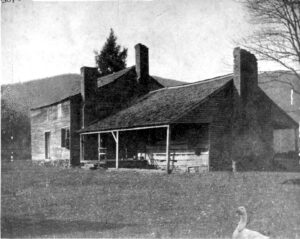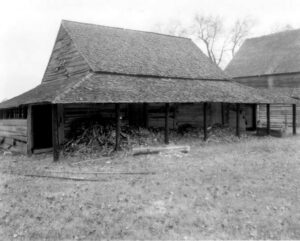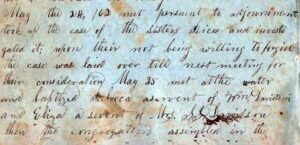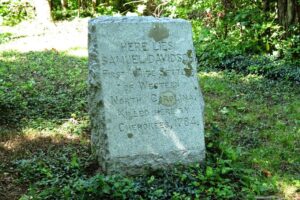
The Revolutionary journeys of 2 young WNC women
Her name does not appear in the written record until her ancestor, Johnny Baxter, gave an interview identifying her in the 1980s. He recalled, “My grandmother on my mother’s side was an indentured slave, and was held by the Davidson family. Her (grand)mother was also held by the Davidsons … and was with Samuel Davidson and his family when he was scalped by the Indians.”



“Disguised as an old woman, and riding horseback, she went from her home … near the Catawba River (in North Carolina) to the Fort at Ninety-Six, South Carolina. The message (she carried) was, ‘Hold out, more men are coming,’” wrote Catherine Rebecca Carson in 1934 of her ancestor Ruth Davidson’s folkloric journey, which was said to have aided the Patriot cause during the Revolutionary War.
Despite some discrepancies in the historic record in verifying 18th century ages and dates, many historians and genealogists believe that Ruth Davidson also played a central role in one of the most notorious early settlement stories in Western North Carolina history – a story passed down through the generations in which another strong-willed teenager, Liza, carried a child to safety on a similarly heroic journey.
The first known written version of this earlier story, as told by Robert Brank Vance Davidson in 1870, reads: “Our granduncle, Samuel Davidson, was killed by the Indians about the year 1776. He had worked his horse all day and turned him out to grass at night. Next morning he walked out to get his horse, and had not been long gone until his wife heard the sound of a rifle shot: and, taking the alarm, she snatched up her infant daughter, Ruth, and leaving the path, she made her way across the Blue Ridge about twenty miles to (Davidson’s Fort) on its eastern slope. A negro woman left about the same time, and made her way back to the fort along the path.”
Though not much has been discovered relating to the identity of Samuel’s wife – she may have been Mary Smith, a sister of his friend, Daniel Smith – more has been uncovered related to the life of the other woman living with Samuel at the time of his death, the “negro woman” he enslaved.
Her name does not appear in the written record until her ancestor, Johnny Baxter, gave an interview identifying her in the 1980s. He recalled, “My grandmother on my mother’s side was an indentured slave, and was held by the Davidson family. Her (grand)mother was also held by the Davidsons … and was with Samuel Davidson and his family when he was scalped by the Indians.”
In a subsequent interview Baxter spoke again of his great-great-grandmother. Her name was Liza and in Baxter’s telling, Liza was a strong-willed teenager who saved Mary and Ruth Davidson by dragging them down the mountain, off the main trail and under the cover of darkness, to safety within the walls of Davidson’s Fort (present-day Old Fort, North Carolina). As a tribute, Baxter’s family named a child after the heroic Liza every generation.
Once the women arrived at the fort, several men, including Samuel’s twin brother, William, and his friend, Daniel Smith, organized an avenging party. They scaled the mountain, located Samuel’s body, buried him a shallow grave, and found and murdered a number of Cherokee men they found nearby.
At this time, the Swannanoa Gap – the main pathway between Davidson’s Fort and the mountaintop where Samuel Davidson was killed in present-day Swannanoa – was a busy thoroughfare as colonists attempted to push farther west into Cherokee territory and Cherokee people resisted this encroachment.
During the summer of 1776, Cherokee men had attacked several white settlements, killing 37 people. In retaliation, on Sept. 1, 1776, General Griffith Rutherford and 2,500 men left Davidson’s Fort and traveled up the Swannanoa Gap – the same path taken by the Davidson family as they attempted to settle Western North Carolina – burning 36 Cherokee villages farther west and leaving no homes, crops, or livestock unscathed.
Despite his early demise and likely illegal encroachment on Cherokee territory, Samuel Davidson has long been celebrated as the “First White Settler of Western North Carolina,” as his grave marker declares.
During the dedication of the stone marker in 1913, another of Samuel Davidson’s ancestors, historian Forster Sondley, told a similar story of Davidson’s death. The basic details were much the same as Robert Davidson’s had been in 1870 except Sondley – and the marker – date Samuel’s death to late 1784 instead of 1776.
This 12-year discrepancy between the two versions of the story is significant not only because treaties between the colonists and the Cherokee did not open the Swannanoa Valley to legal settlement until 1785, but also because Ruth, who was said to be an infant or young child when her father was killed, had been 16 years old by the time she was said to have ridden in disguise to Ninety-Six, South Carolina, in 1781.
Adding more credence to the earlier date of Samuel’s death, Robert Davidson also recalled that, “About fifteen years ago (in 1855) Mack Gudger, plowing a field near where Samuel Davidson was killed by the Indians, found a polished stone on which is rudely cut ‘D. S. 1775,’ and on the opposite side ‘S.D.’ These letters are supposed to stand for ‘Daniel Smith’ (Samuel’s closest friend) and ‘Samuel Davidson.’ Gudger gave me the stone. Hugh Davidson is now in possession of this stone, which he values highly.”
In Sondley’s 1913 version of the story, “the letters ‘S. D.’ were cut in a pine tree which stood at the head of (Samuel Davidson’s) grave; and (his nephew) Samuel W. Davidson always kept these letters freshened, in order that they might not become obscured by the accretion of moss or the growth of the tree.” When Samuel W. Davidson died in 1858, the pine died and rotted away. For the intervening half century, Samuel Davidson’s grave was seemingly unmarked.
Prior to Samuel’s death, his twin brother William had built a log home on the Catawba River about 4.5 miles from Davidson’s Fort. Known as “The Glades,” it was at this home in which Mary and Ruth – and to a lesser extent, Liza, who remained enslaved – found refuge after Samuel’s death and, potentially, the home from which Ruth would leave on horseback carrying an important message during the Revolutionary War years later.
By May 1780 the British had won several important battles in South Carolina and were planning to invade North Carolina. After British and Loyalist forces pushed into North Carolina in late 1780, General Nathanael Greene took over command of the southern army and began reorganizing the troops in Virginia. By 1781 another British force threatened the backcountry of South Carolina and Greene needed to send a communication to the American troops there. Greene’s message arrived at The Glades, where North Carolina’s Patriot forces often held meetings under the direction of William Davidson.
When 16-year-old Ruth heard of the need for a courier, she proposed that she take the message as she felt it unlikely that they would suspect a woman of carrying militarily-important intelligence.
Ruth rode more than 100 miles alone over rough terrain and successfully delivered the missive to the Patriot troops in South Carolina. These detached troops now knew that Greene and hundreds of Patriot troops were headed their way to offer assistance. From May 22 until June 18, 1781, Greene staged a siege of the loyalist forts at Ninety-Six. Though Greene failed to take the fort, this battle proved to be a first step in Greene’s campaign to retake the Carolinas, which was ultimately essential to an American victory in the Revolutionary War.
In 1785, the United States and Cherokee signed the Hopewell Treaty. As a result, the Cherokee ceded more land to the colonists, including the land between present-day Black Mountain and East Asheville, which contained Samuel Davidson’s final resting place. It was then that Samuel Davidson’s extended family and the people they enslaved journeyed up the mountain and settled not far from Samuel’s grave near the confluence of the Swannanoa River and Bee Tree Creek, and formed the first white settlement in western North Carolina. It was known as the Swannanoa Settlement.
It is likely that Liza traveled with William Davidson’s family as they made their way to settle near Bee Tree Creek. Her daughter and granddaughter, according to Baxter, were also enslaved by the Davidson family.
In 1838, Sophronia S. Burgin Davidson, a granddaughter of William Davidson, turned 21. Her father, John Burgin, gifted her five of the people he enslaved, including Eliza and Tom Lindsey, who may have been the great-grandparents of Johnny Baxter.
Baxter recalled, “My grandmother, Eliza, was born on one of the Davidson plantations in 1839. She stayed with the Davidsons until … she purchased her freedom in order to marry a man by the name of John Henry, who had purchased his freedom from the Henry family.”
And, in the few existing primary documents recording the names of enslaved people in the Swannanoa area prior to the end of the Civil War, it shows that on May 25, 1862, the congregation of Berea Baptist “met at the water and baptized … Eliza a servant of Mrs. S.S. Davidson.”After gaining her own freedom, Eliza moved to live with her husband, John Henry, in the Chunns Cove area of Asheville. Johnny Baxter remembered of his grandparents, “John Henry was deeply involved in the anti-slavery movement, his home was part of the underground railroad system. … My grandmother was very helpful in the operation of their station as she was an expert cook. … She died in 1945 at the age of 106 years.”
Ruth Davidson’s life and the lives of her children took a different trajectory. According to Robert Davidson’s 1870 account, “The infant, Ruth, grew up and married James Wilson; and some time in the present century they settled in Williamson County, Tennessee, where their descendants now live, a highly respected family.” Davidson family genealogists tend to agree that Ruth Davidson Wilson was also the teenage Patriot who rode to Ninety-Six.
As a married woman, Ruth settled down and became the mother of at least nine children. She and her husband also enslaved at least 33 people including Patsy, Peggy, Newson, Rebecca, John, Fanny, George, Catherine, and Berry. Ruth died in 1826.
Ruth’s children married and went on to own large plantations of their own. Her daughter, Rebekah, for instance, married Joseph McDowell Carson in 1808 and moved into his 42-room mansion at Green River Plantation near Rutherfordton. On her wedding trip from Tennessee to North Carolina “her household goods and slaves followed in a baggage wagon. ‘Patsy Mammy,’ one of the slaves who came with her, was for years (the) cook at Green River,” remembered Catherine Rebecca Carson in 1934. “We still have some of her recipes she used, the favorite being Apple Cake.”
Anne Chesky Smith is the executive director of Asheville Museum of History.
